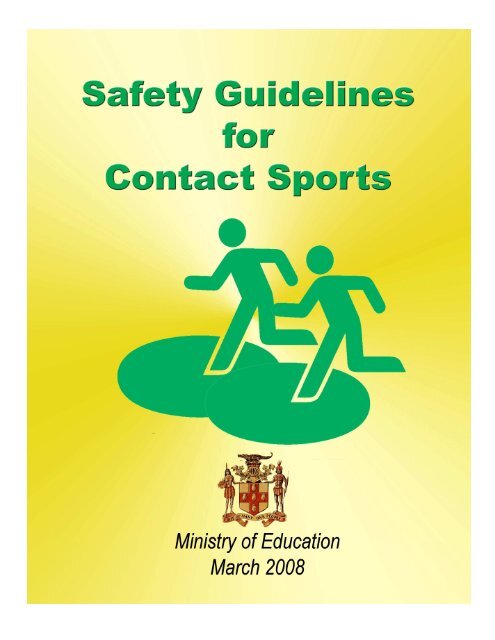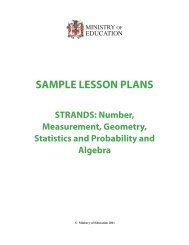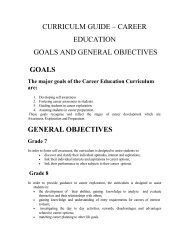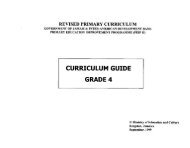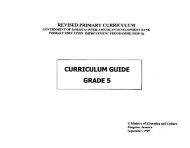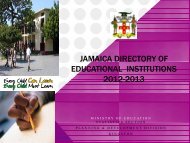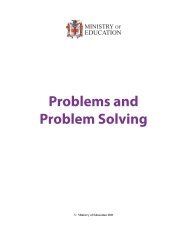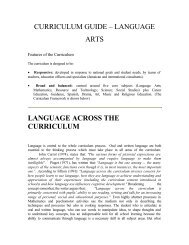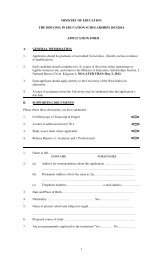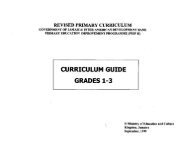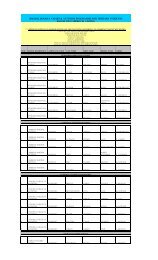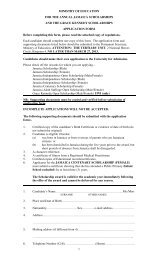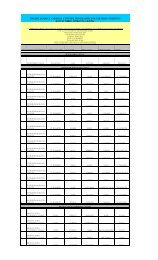Safety Guidelines for Contact Sports Manual.pdf - Ministry of Education
Safety Guidelines for Contact Sports Manual.pdf - Ministry of Education
Safety Guidelines for Contact Sports Manual.pdf - Ministry of Education
Create successful ePaper yourself
Turn your PDF publications into a flip-book with our unique Google optimized e-Paper software.
<strong>Safety</strong> <strong>Guidelines</strong><br />
<strong>for</strong><br />
<strong>Contact</strong> <strong>Sports</strong><br />
<strong>Ministry</strong> <strong>of</strong> <strong>Education</strong><br />
March 2008
<strong>Ministry</strong> <strong>of</strong> <strong>Education</strong><br />
Caenwood Centre<br />
37 Arnold Road<br />
Kingston 4<br />
<strong>Safety</strong> <strong>Guidelines</strong> <strong>for</strong> <strong>Contact</strong> <strong>Sports</strong> © <strong>Ministry</strong> <strong>of</strong> <strong>Education</strong> 2008<br />
This edition published in 2008.<br />
All rights reserved. No part <strong>of</strong> this publication may be reproduced in any <strong>for</strong>m (including<br />
photocopying or storing it in any medium by electronic means and whether or not transiently or<br />
incidentally to some other use <strong>of</strong> this publication) without the written permission <strong>of</strong> the<br />
copyright holder, except in accordance with the provisions <strong>of</strong> Jamaica’s Copyright Act 1993.<br />
Application <strong>for</strong> the copyright owner’s written permission to reproduce any part <strong>of</strong> this<br />
publication should be addressed to the publisher:<br />
The Permanent Secretary<br />
<strong>Ministry</strong> <strong>of</strong> <strong>Education</strong><br />
Caenwood Centre<br />
37 Arnold Road<br />
Kingston 4<br />
Acknowledgements<br />
Written by Dr. Joyce Graham-Royal<br />
<strong>Education</strong> Officer ― Physical <strong>Education</strong> and Sport<br />
Editing, design and layout by Media Services Unit, <strong>Ministry</strong> <strong>of</strong> <strong>Education</strong>, Caenwood Centre,<br />
37 Arnold Road, Kingston 4.<br />
Printed and bound in Jamaica by Expedite Printers.
TABLE OF CONTENTS<br />
1. INTRODUCTION...................................................................... 1<br />
2. ORGANISATION & ADMINISTRATION ................................... 2<br />
3. PROFESSIONAL LEADERSHIP.............................................. 3<br />
4. ACTIVITIES.............................................................................. 4<br />
5. FACILITIES & EQUIPMENT..................................................... 5<br />
6. HEALTH & SAFETY OF PARTICIPANTS ............................... 6<br />
7. DAILY PHYSICAL EDUCATION ROUTINES ........................... 7<br />
8. PHYSICAL ACTIVITY & SPECIAL NEEDS .............................. 7<br />
9. OUTDOOR SAFETY FOR PHYSICAL ACTIVITY .................... 8<br />
10. PRE-PARTICIPATION PHYSICAL EXAMINATION ................. 9<br />
11. PHYSICAL EDUCATION & SAFETY CURRICULUM ............ 10<br />
12. PROTECTIVE GEAR & SAFETY EQUIPMENT ..................... 11<br />
13. SUMMARY............................................................................. 12<br />
14. AWARDS ............................................................................... 13<br />
15. EVALUATION ........................................................................ 13<br />
16. CONCLUSION ....................................................................... 15
1<br />
INTRODUCTION<br />
The purpose <strong>of</strong> these guidelines is to provide educators in the discipline <strong>of</strong> physical education,<br />
school-activity directors, administrators and programme leaders with basic in<strong>for</strong>mation <strong>for</strong><br />
planning and implementing physical education and sports and other intramural programmes <strong>for</strong><br />
students from early childhood to Grade 12, and also at the tertiary level. In addition, the<br />
guidelines are intended to disclose and protect the rights and responsibilities <strong>of</strong> all<br />
stakeholders, safeguard against injury and fatality, and prevent or minimise litigation.<br />
All students should receive basic instruction in motor skills and sports activities through<br />
comprehensive physical education programmes. Such programmes facilitate the skills and<br />
knowledge necessary to support an active, productive and healthy lifestyle. Intramural and<br />
other physical activity programmes extend and complement physical education to ensure that<br />
all persons are given an opportunity, regardless <strong>of</strong> athletic skills, to participate in lifetime<br />
physical activity that can contribute to their enjoyment <strong>of</strong> leisure time and their emotional<br />
well-being. School-based programmes promoting and providing physical activity should be<br />
available to students at primary, secondary and tertiary levels.
ORGANISATION AND ADMINISTRATION<br />
All stakeholders must pay careful attention to the following guidelines, as they relate to the<br />
organisation and administration <strong>of</strong> instruction <strong>for</strong> physical education classes and extra-mural<br />
programmes:<br />
• All schools and other institutions <strong>of</strong>fering these programmes should employ trained and<br />
qualified teachers <strong>of</strong> physical education as well as trained and qualified coaches.<br />
• Schools and other institutions should provide physical activity opportunities <strong>for</strong> students<br />
outside the physical education programme. Intramural programmes do not replace a<br />
physical education curriculum, but provide additional outlet <strong>for</strong> learning achieved in<br />
physical education classes.<br />
• Intramurals should be considered an enhancement <strong>of</strong> the school’s physical education<br />
curriculum.<br />
• Intramurals should be directed by pr<strong>of</strong>essional educators. They should have access to<br />
adequate facilities and equipment, ensure safety <strong>of</strong> participants, and be adequately<br />
funded.<br />
• Grouping <strong>of</strong> students during physical education activities should be based on ageappropriate<br />
activities as well as consideration <strong>of</strong> skill and maturity level.<br />
• Institutions should ensure that minimum standards are met as prescribed by the sports<br />
governing bodies to which they are affiliated - Primary Schools <strong>Sports</strong> Association<br />
(PSSA), Jamaica Independent Schools <strong>Sports</strong> Association (JISSA), Inter-Secondary<br />
Schools <strong>Sports</strong> Association (ISSA), Jamaica Inter-Collegiate <strong>Sports</strong> Association (JISA) -<br />
be<strong>for</strong>e participating in any sporting events.<br />
• Schools should ensure that all sports in which they participate are run by the institutions’<br />
sports governing bodies (PSSA, JISSA, ISSA and JISA).<br />
2
PROFESSIONAL LEADERSHIP<br />
Pr<strong>of</strong>essional preparation in physical education or recreation requires appropriate qualifications<br />
<strong>for</strong> leaders responsible <strong>for</strong> intramural and physical education programmes.<br />
Specific competencies include:<br />
• Understanding cognitive, psychosocial, and psychomotor development <strong>of</strong> youth.<br />
• Knowledge about components <strong>of</strong> physical fitness and appropriate training principles.<br />
• Knowledge <strong>of</strong> particular sport and other physical activities including skills, rules and<br />
<strong>of</strong>ficiating techniques <strong>for</strong> a variety <strong>of</strong> occasions or event types.<br />
• Knowledge <strong>of</strong> programme planning and various resources available <strong>for</strong> providing<br />
appropriate physical activity experiences.<br />
• Knowledge and skills related to organising competitions (teams, ladders, tournaments,<br />
practices, rotations, etc.)<br />
• Knowledge <strong>of</strong> sports safety requirements and first aid.<br />
3
4<br />
ACTIVITIES<br />
The programme <strong>of</strong> activities should include competitions in various sports clubs and <strong>for</strong>a.<br />
Activities should be dedicated to promoting healthy lifestyles, be self-directed and be special<br />
events such as sports days, field trips, instructional and practice opportunities associated with<br />
a particular sport.<br />
<strong>Guidelines</strong> <strong>for</strong> selection should include:<br />
• Provision <strong>of</strong> opportunities <strong>for</strong> inclusion <strong>of</strong> male, female, and co-educational<br />
participation. Organisations should facilitate full participation <strong>of</strong> all students in all<br />
activities.<br />
• Activities that meet the needs <strong>of</strong> all skill levels and physical abilities, including students<br />
with disabilities.<br />
• Modification and accommodation <strong>of</strong> activities, so that they are appropriate to the age,<br />
physical development and skill levels <strong>of</strong> individual participants. In some cases, height<br />
and weight may be <strong>of</strong> more importance than age or grade level in determining<br />
groupings <strong>for</strong> team and individual competition.<br />
• Specific rules and regulations that ensure equal opportunity, fair play, and safe<br />
participation.<br />
• Activities that reflect student interest and provide challenge, enjoyment and moderate<br />
to vigorous activities <strong>for</strong> all participants.<br />
• Constant liaison with classroom teachers regarding the mental health, behaviour and<br />
welfare <strong>of</strong> marginal/disabled students.
FACILITIES AND EQUIPMENT<br />
Adequate facilities and equipment are critical to support the success <strong>of</strong> physical activity<br />
programmes. Programmes may be modified and adapted to meet the budget and<br />
indoor/outdoor space available.<br />
Basic guidelines include:<br />
• Establishing adequate facilities to meet the needs, interests and number <strong>of</strong> participating<br />
students.<br />
• Implementing safety standards <strong>for</strong> each activity in the programme.<br />
• Establishing cycles and personnel <strong>for</strong> inspecting and monitoring the wear and tear <strong>of</strong><br />
equipment.<br />
• Discarding or repairing damaged equipment to avoid injury.<br />
• Ensuring that the quantity and type <strong>of</strong> equipment is suited to the specific programme<br />
and meets the needs <strong>of</strong> participants so that programmes can serve the maximum<br />
number <strong>of</strong> persons under established safety standards.<br />
• Modifying equipment according to age, size and/or physical ability <strong>of</strong> the participants.<br />
• Implementing regular random inspections to ensure safety <strong>for</strong> all activities.<br />
5
HEALTH AND SAFTEY OF PARTICIPANTS<br />
Physical activity programmes enhance the health and fitness <strong>of</strong> participants. The following<br />
guidelines are recommended:<br />
• Stakeholders must familiarise themselves with established guidelines and policies that<br />
outline procedures <strong>for</strong> accident prevention, management <strong>of</strong> injury situations, reporting,<br />
and notification <strong>of</strong> parents/guardians in the event <strong>of</strong> an emergency.<br />
• All activities should be structured to ensure that safety requirements are met, including<br />
consideration <strong>for</strong> each participant’s readiness <strong>for</strong> the activity, based on age, skill,<br />
physical condition and level <strong>of</strong> supervision provided.<br />
• All participants should have medical clearance to participate.<br />
• Medical problems that may affect participation should be communicated to the<br />
programme leader. Medical clearance should be reaffirmed on a periodic basis.<br />
• Parents/Guardians must provide in<strong>for</strong>med consent <strong>for</strong> participants who are under 18<br />
years old.<br />
• Immediate first aid must be available from trained providers whenever the programme is<br />
in progress. First-aid equipment must be available on-site, as part <strong>of</strong> the budgeted<br />
programme, and must be regularly maintained.<br />
• Communication channels to parents/guardians, health providers, and emergency<br />
caregivers, especially in emergency situations, must always be generally known and<br />
available.<br />
• Student-teacher ratio must con<strong>for</strong>m to <strong>Ministry</strong> <strong>of</strong> <strong>Education</strong> recommendations <strong>for</strong> both<br />
intramural and intermural operations.<br />
• Students must be supervised at all times, while under the care <strong>of</strong> the school.<br />
• Locker rooms (where applicable) should be supervised with clear rules <strong>for</strong><br />
recommended student behaviour.<br />
6
DAILY PHYSICAL EDUCATION ROUTINES<br />
Provision should be made <strong>for</strong> all students at early childhood through to Grade 12 to access<br />
opportunities <strong>for</strong> daily physical exercise, because the body and mind need exercise to maintain<br />
optimum health and emotional wellbeing. This time must be dedicated to physical exercise<br />
only, and not used <strong>for</strong> any other activities.<br />
PHYSICAL ACTIVITY AND SPECIAL NEEDS<br />
Schools and other institutions must establish and en<strong>for</strong>ce policies and practices that enable<br />
students with disabilities and other special health care needs to participate fully and safely in<br />
physical education and other physical activity programmes.<br />
Students with disabilities need to experience the same quality <strong>of</strong> physical education and be<br />
<strong>of</strong>fered equivalent opportunities to participate in physical activity <strong>of</strong>fered to other students.<br />
There should, however, be modifications and accommodations to meet such special needs.<br />
These students require physical activities designed to increase physical endurance, strength,<br />
dexterity and skills. Each student with a special health care need or disability requires an<br />
assessment <strong>of</strong> how the disability or special health care need will impact or be impacted by<br />
participation in any given activity. This includes assessment <strong>of</strong> cognitive abilities and social<br />
skills. Physical activity and physical education programmes must be tailored to meet each<br />
student's specific disability and goals, and allow each one to experience success.<br />
Based on need, physical activity <strong>for</strong> students with disabilities may be delivered in a regular<br />
physical education class or in an adapted physical education class. Sometimes specialised<br />
instruction is required <strong>for</strong> students with disabilities in order to effectively address special<br />
learning styles and modes <strong>of</strong> communication. In addition, protective equipment, safety gear<br />
and surfaces may require modifications to accommodate these students.<br />
7
OUTDOOR SAFETY FOR<br />
PHYSICAL ACTIVITY<br />
Programme managers should establish and en<strong>for</strong>ce policies <strong>for</strong> participation in activities to<br />
protect students and staff from health risks and hazards. When operating outdoors the risks<br />
include overexposure to heat, inclement weather, ultraviolet radiation, air pollution, traffic,<br />
unsafe surfaces, poor lighting, and poorly maintained equipment.<br />
The health and safety <strong>of</strong> students and staff must be considered first and <strong>for</strong>emost when<br />
making decisions about conducting outdoor physical activities.<br />
Specific in<strong>for</strong>mation should be made available as it relates to appropriate clothing, hydration<br />
practices, screening <strong>for</strong> signs <strong>of</strong> dehydration, rest periods, protection from sun exposure, and a<br />
plan <strong>for</strong> reaching medical assistance when necessary. The conditions under which activities<br />
will be cancelled should also be predetermined.<br />
Play areas should be free from debris and water. Separation <strong>of</strong> motor vehicles and other<br />
traffic from play area is essential <strong>for</strong> maintaining a safe environment and reducing injuries.<br />
Where swimming pools are part <strong>of</strong> physical education or activity programmes, safety<br />
procedures must include: maintenance <strong>of</strong> pool water chemistry, en<strong>for</strong>cing rules <strong>of</strong> appropriate<br />
student conduct, constant staff observation, supervision <strong>of</strong> all students, and the presence <strong>of</strong><br />
staff trained in the prevention <strong>of</strong> drowning, near-drowning resuscitation, and in prevention and<br />
initial management <strong>of</strong> diving injuries. Pool rules should be posted at strategic points within the<br />
pool area.<br />
8
PRE-PARTICIPATION<br />
PHYSICAL EXAMINATION<br />
A physical examination, prior to participation in physical activity, and conducted by the<br />
student's primary care provider within a year <strong>of</strong> involvement, should be required <strong>of</strong> students<br />
participating in interscholastic sports.<br />
Pre-participation physical examination <strong>for</strong> student athletes can identify conditions that may<br />
predispose students to injury, be life threatening, or be disabling. Such examinations should<br />
meet national regulatory or school insurance requirements.<br />
A pre-participation physical examination allows <strong>for</strong> the counselling <strong>of</strong> student athletes on<br />
health-related issues, including mental health, and the assessment <strong>of</strong> students' fitness levels.<br />
It is extremely useful to have a standard <strong>for</strong>m <strong>for</strong> purposes <strong>of</strong> documentation and continuity.<br />
Students who have been excluded from participation <strong>for</strong> reasons <strong>of</strong> illness or injury should<br />
receive an additional pre-participation physical evaluation or sports clearance examination<br />
after recovery.<br />
When pre-participation physical examinations are conducted by students’ family physicians,<br />
this allows <strong>for</strong> continuity <strong>of</strong> care by someone who is familiar with the student and family. This<br />
also allows time <strong>for</strong> discussion <strong>of</strong> adolescent risk-taking issues. For students without access to<br />
their own health care providers, it is sometimes necessary to arrange <strong>for</strong> examination <strong>of</strong><br />
students at health centres or through other school-based screening programmes.<br />
Students who receive annual physical assessments by their primary health care providers may<br />
already have all the in<strong>for</strong>mation necessary <strong>for</strong> the pre-participation physical examination.<br />
9
PHYSICAL EDUCATION AND<br />
SAFETY CURRICULUM<br />
Staff, students and caregivers must be educated about the dangers <strong>of</strong> substance abuse,<br />
misconduct during physical activity, proper nutrition, extreme weight control practices (rapid<br />
weight gain or loss), and the importance <strong>of</strong> using safety gear as well as other aspects <strong>of</strong> safe<br />
participation in physical activities. <strong>Safety</strong> education must be a major component <strong>of</strong> the<br />
physical education programme.<br />
Substance abuse and misconduct adversely affect safety during physical activity. Alcohol,<br />
other psychoactive drugs, and extreme weight control practices are examples <strong>of</strong> student<br />
indulgencies that can have long-term adverse consequences on the body.<br />
The use <strong>of</strong> alcohol and other drugs increase the chances <strong>of</strong> injury through impaired judgement<br />
and delayed reaction time. Many per<strong>for</strong>mance-enhancing products and substances are readily<br />
available and are <strong>of</strong>ten legally purchased. Many <strong>of</strong> these substances may pose numerous or<br />
significant health hazards.<br />
To correct erroneous associations between nutritional supplements and athletic<br />
accomplishment, teachers and coaches should emphasize that a nutritious diet <strong>of</strong> healthy<br />
foods also promotes muscle growth and optimal per<strong>for</strong>mance. Students should be<br />
encouraged to keep a record <strong>of</strong> their own practice, training, and per<strong>for</strong>mance improvement so<br />
that accomplishments in athletic endeavours are easily seen to be more closely associated<br />
with ef<strong>for</strong>t and practice, than being a ‘magic’ response to crash diet and stimulants.<br />
Bullying, harassment, unsportsmanlike conduct and violent behaviour are hazardous to<br />
student and staff safety, and discourage many students from participating in physical activities.<br />
Teachers/Coaches should work with classroom teachers to educate students about acceptable<br />
behaviour in play areas. Teachers/Coaches should in<strong>for</strong>m them <strong>of</strong> rules and the<br />
consequences <strong>of</strong> breaking these rules. Coaches, physical education teachers, and those<br />
supervising other physical activities must be trained to recognise and to educate students and<br />
caregivers about the importance <strong>of</strong> the signs and symptoms <strong>of</strong> injuries (including muscle,<br />
bone, head and abdominal injuries) and action should be taken when they occur. They should<br />
teach students the rationale and procedure <strong>for</strong> removing a student from a physical activity after<br />
an injury and <strong>for</strong> seeking medical assessment and assistance.<br />
10
PROTECTIVE GEAR AND<br />
SAFETY EQUIPMENT<br />
Physical education instructors, coaches and caregivers require the use <strong>of</strong> appropriate safety<br />
equipment and protective gear in physical education classes, interscholastic and intramural<br />
sports, and all other physical activity programs.<br />
Minimising physical activity-related injuries and illnesses <strong>for</strong> students is a joint responsibility <strong>of</strong><br />
teachers, supervisors <strong>of</strong> physical activity programs, coaches, students and families.<br />
<strong>Safety</strong> gear should be sport-specific and strictly mandatory <strong>for</strong> the respective activity.<br />
Protective gear and safety equipment must be frequently inspected and replaced if worn,<br />
damaged, or outdated. <strong>Safety</strong> gear worn by students should fit properly. Protective gear<br />
should be worn during practice sessions as well as during competitions.<br />
11
The following is a summary <strong>of</strong> the guidelines detailed in this document:<br />
12<br />
SUMMARY<br />
• Trained, qualified Physical <strong>Education</strong> teachers and coaches must conduct physical<br />
activities.<br />
• There must be mandatory insurance coverage <strong>for</strong> both teachers and students.<br />
• Equipment must be in good condition and should be: age, ability and size appropriate<br />
with no sharp or dangerous edges.<br />
• Equipment should be checked regularly be<strong>for</strong>e and after use and should be<br />
repaired/discarded as necessary.<br />
• First-aid kits should be maintained and readily accessible.<br />
• Medical personnel should be present during competitions.<br />
• Licensed and insured vehicles must be available to transport injured participants <strong>for</strong><br />
further treatment.<br />
• Each institution should be affiliated to the hospital to which it is most closely located.<br />
• Injured participants must be referred <strong>for</strong> further medical attention/follow-up treatment.<br />
• Equipment must be properly maintained and stored.<br />
• Teachers, administrators, children and parents should be aware <strong>of</strong> safety<br />
guidelines/risks involved in participation in sporting activities.<br />
• Visual supervision, on-site supervision, and in-the-area supervision is mandatory during<br />
classes or sport competitions.<br />
• Instructors, coaches and supervisors must abide by the recommended ratio <strong>of</strong> students<br />
to teachers.<br />
• <strong>Safety</strong> gear and appropriate footwear must be worn <strong>for</strong> each activity.<br />
• <strong>Safety</strong> checks should be done on facilities/playing areas, to isolate and identify potential<br />
hazards. (Children must be made aware <strong>of</strong> potential hazards.)<br />
• Only materials that will not endanger children who suffer from severe allergies or<br />
disabilities should be used.
• Throwing implements should be handled with care.<br />
13<br />
SUMMARY cont’d<br />
• Implements should not be used (by teacher or student) to strike a person.<br />
• Administrators, teachers/coaches and parents should ensure that athletes are on an<br />
appropriate feeding programme.<br />
• Athletes must be properly fed (given balanced meals) and hydrated be<strong>for</strong>e, during and<br />
after competitions.<br />
• Teachers, coaches and parents/guardians should be aware <strong>of</strong> medical conditions<br />
affecting every athlete.
14<br />
AWARDS<br />
The focus <strong>of</strong> intramural programmes is participation. Modest recognition <strong>for</strong> participation may<br />
be appropriate. There should also be opportunity <strong>for</strong> recognition <strong>of</strong> excellence leading to<br />
representational participation at the intermural level.<br />
EVALUATION<br />
Intermural programmes must be subject to continuous, structured evaluation. Areas to be<br />
reviewed include:<br />
• Objectives<br />
• Programme Activities<br />
• Facilities/equipment<br />
• Level/frequency <strong>of</strong> participation<br />
• <strong>Safety</strong><br />
• Organisation/administration<br />
• Student response<br />
The results <strong>of</strong> the evaluation allow <strong>for</strong> modification <strong>of</strong> objectives, planning and implementation<br />
<strong>of</strong> programme needs, justification <strong>for</strong> budgets, and programme improvement.
15<br />
CONCLUSION<br />
Regular physical activity, whether organised through direct class involvement or as part <strong>of</strong> a<br />
co-curricular programme, is essential <strong>for</strong> normal, healthy growth and development, emotional<br />
wellbeing and creative expression. Participation allows students to understand and make<br />
decisions regarding personal fitness as well as to recognise the value <strong>of</strong> physical activity to<br />
their daily lives. Regular evaluation helps to measure the extent to which students are<br />
benefiting from their involvement. These safety guidelines have been prepared to in<strong>for</strong>m and<br />
to protect the rights, responsibilities and wellbeing <strong>of</strong> all stakeholders involved in the planning<br />
and execution <strong>of</strong> physical education classes and programmes. They may be instrumental in<br />
preventing or minimising injuries arising from un<strong>for</strong>eseen circumstances affecting<br />
students/athletes, and should there<strong>for</strong>e be carefully read, observed and applied.
16<br />
NOTES


